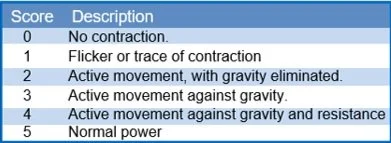Is Exercise Okay In Polio Survivors After Surgery or Immobility?
New weakness can be caused by a leg, arm, hip or shoulder being immobilized or after having had surgery. Is exercise okay to treat new muscle weakness after surgery or immobility, say having your leg in a cast for six weeks? I'm sure you think my answer is no. But the answer is a very qualified "possibly".
Let's first talk about muscle strength, which is measured on a six point scale from 0 (paralyzed, having no strength) to 5 (muscle so strong that the therapist can't "break" your muscle’s contraction).
Say you have a knee replaced and your quadriceps (thigh muscle) strength drops after surgery from 4/5 to 3/5, from "pretty strong" to just being able to raise your lower leg against gravity. This loss of strength likely is not due to new post-polio muscle weakness and neuron failure, but to the effects of surgery.
Is it okay to exercise to bring your strength from 3 back to 4?
Canadian physiatrist Rubin Feldman developed a protocol for just this situation: 50% non-fatiguing exercise (Orthopedics. 1985 Jul;8(7):889-90).
50% non-fatiguing exercise is when a patient does half the amount of exercise that causes any symptom: be it muscle weakness, fatigue, shaking or pain.
Polio survivors are amazed when this often piddling amount of exercise increases muscle strength and endurance following immobility or surgery. But, Feldman warns never to perform even 50% non-fatiguing exercise in muscles with less than antigravity strength – muscles graded less than 3/5 that can't lift their limb’s weight against gravity - and is not intended to treat post-polio muscle weakness.
Why is non-fatiguing exercise okay after surgery but not recommended for treating post-polio muscle weakness? Think of your muscle strength as a bucket of water. Surgery or being in a cast scoops water out of the bucket and non-fatiguing exercise puts the water back. Post-polio muscle weakness is like having a hole in the bucket that is draining off your muscle strength and exercise will just make the hole in the bucket bigger.
Take this article with you to your first session with the physical therapist, explain that you are a polio survivor and must only do non-fatiguing exercise to prevent further motor neuron damage. Count the number of repetitions of exercises that you are given to identify the point where you feel any symptoms: muscle weakness or shaking, fatigue or pain. Then, talk to the therapist about doing only half of the number of symptom-causing repetitions to protect your neurons.
Please know that the success of 50% non-fatiguing exercise completely depends on polio survivors being aware of their symptoms, stop exercising when symptoms are felt and not being cowed by therapists demanding that you "push through and feel the burn".
Source: The use of strengthening exercises in post-polio sequelae. Methods and results

